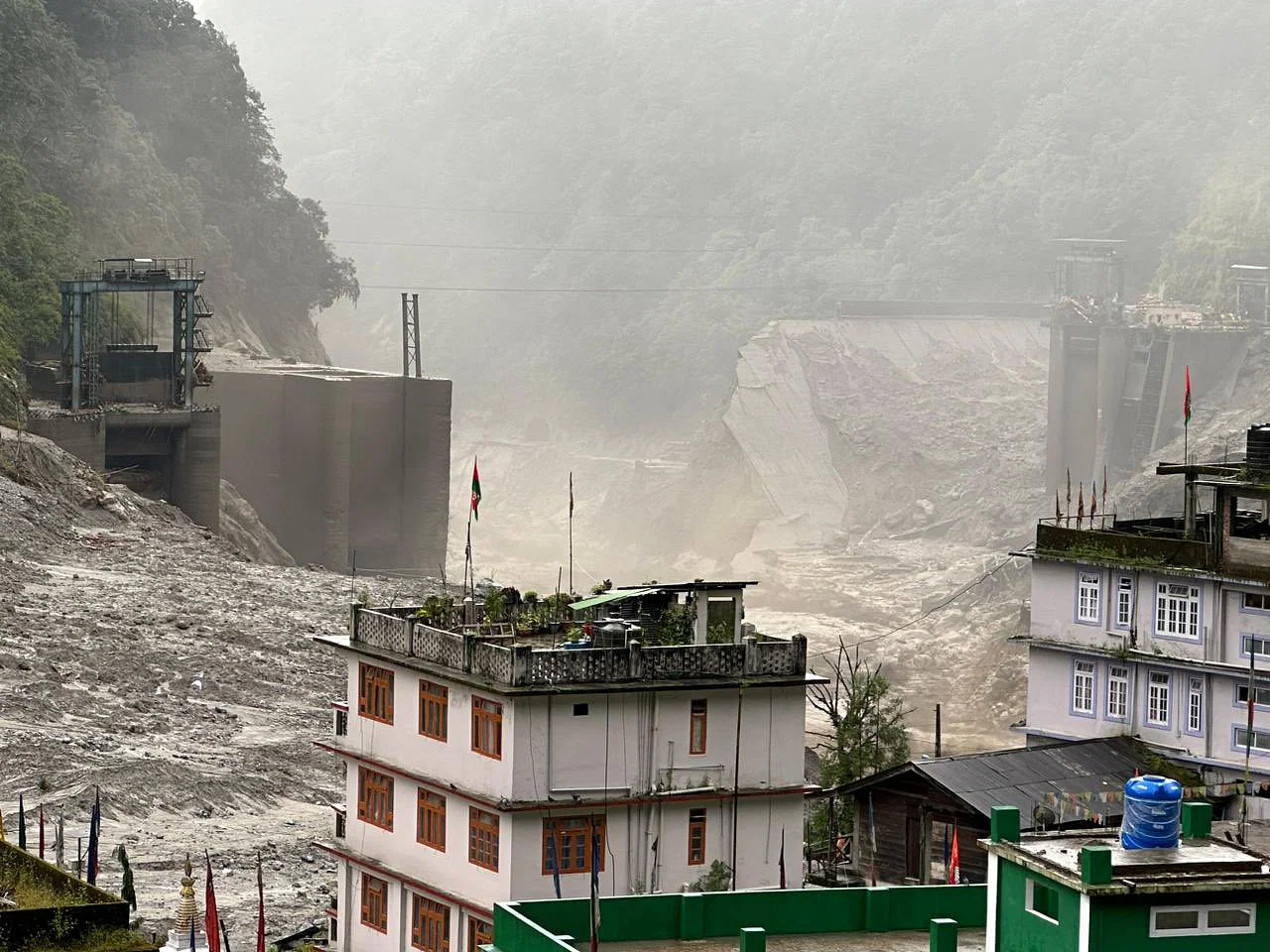The Sikkim flood in India can help others prepare for similar disasters
The 2023 Sikkim flood reveals the rising threat of glacial lake outburst floods, fueled by climate change. Scientists push for urgent risk management.

The lake outburst in portions of Lhonak Lake in North Sikkim caused a rise in water levels with very high velocities near about 15m/sec, crossed the CWC Melli site measuring 227 m, near about 3m above Danger Level. (CREDIT: ISRO/NRSC satellite imagery)
The October 3, 2023, glacial lake outburst flood (GLOF) in the Sikkim Himalaya, India, was a catastrophic event triggered by a collapsing lateral moraine. This massive chunk of frozen debris tumbled into South Lhonak Lake, generating a 20-meter-high impact wave.
The surge breached the lake’s moraine dam, unleashing 50 million cubic meters of water. As the flood traveled downstream, it eroded 270 million cubic meters of sediment, overwhelming infrastructure and wiping out entire communities.
The destruction reached hundreds of kilometers along the Teesta River, submerging homes, farmlands, and roads. Hydropower facilities, including the 1,200-megawatt Teesta-III dam, were devastated. The disaster left 55 people dead and 74 missing. The cascading effects of this flood highlight the growing risks in high-altitude regions due to climate change and human activity.
The Science Behind a Multihazard Cascade
Glacial lake outburst floods are unpredictable yet devastating. They occur when lakes formed by melting glaciers suddenly release enormous amounts of water. The Himalayas, home to over 2,400 lakes larger than 0.1 square kilometers, are highly vulnerable. Many of these lakes are expanding as temperatures rise, increasing the risk of catastrophic floods.
The Sikkim flood began with a moraine collapse, which triggered a tsunami-like wave. This wave surged through the valley, breaking the moraine dam and unleashing a torrent of water. The floodwaters carried with them vast amounts of sediment, transforming into a debris-laden flood that destroyed everything in its path.
Dr. Dan Shugar, a geomorphologist at the University of Calgary, explains, “A landslide went into a lake, and that triggered a wave that eroded a dam at the end of the lake, resulting in a slurry-like flood for hundreds of kilometers.”
His team, along with international researchers, used satellite imagery, seismic data, and meteorological records to reconstruct the event in a recent paper published in Science.
The flood’s devastation extended beyond India, impacting West Bengal and even causing transboundary effects in Bangladesh. The disaster’s scale led the World Meteorological Organization to declare it one of Asia’s worst climate-related disasters of the year.
Related Stories
Climate Change and the Rising GLOF Threat
Warming temperatures are accelerating glacier melt, leading to larger glacial lakes that pose increasing dangers. Dr. Ashim Sattar, lead author of the study, warns, “Glacial lakes are growing in number and size, so they need to be critically and urgently evaluated for downstream hazards.”
In the Himalayas, rising permafrost temperatures destabilize mountain slopes. These unstable slopes increase the risk of rock-ice avalanches, which can trigger massive floods like the one in Sikkim. Similar disasters have struck the region before, including:
- The 2016 Gongbatongsha GLOF in Nepal, which obliterated hydropower infrastructure.
- The 2021 Chamoli rock-ice avalanche in India, which killed over 200 people and destroyed multiple dams.
Beyond the Himalayas, other mountain regions face similar threats. In 2020, a glacial lake outburst flood in British Columbia, Canada, wiped out salmon spawning habitats and destroyed forests.
Dr. Shugar, who has studied both the Sikkim and British Columbia floods, stresses the need for early warning systems. “These events have serious implications for people and infrastructure. Advances in Earth observation technologies have dramatically improved our ability to understand these sorts of events, leading to disaster risk reduction.”
Protecting Communities from Future Disasters
With the Himalayas holding an estimated 500-gigawatt hydropower potential, rapid development continues despite the risks. Over 650 hydropower projects are planned or under construction in High Mountain Asia, many in flood-prone valleys. However, these projects remain highly vulnerable to natural disasters.
The recent Sikkim flood underscores the urgent need for better hazard assessment and early warning systems. Experts suggest the following measures to mitigate risk:
- Real-Time Monitoring: Using satellites, drones, and seismic sensors to track changes in glacial lakes and unstable slopes.
- Early Warning Systems (EWS): Installing automated alarms that can alert downstream communities minutes or hours before a flood.
- Engineering Solutions: Reinforcing hydropower infrastructure to withstand extreme flood events.
- Community Preparedness: Educating residents on evacuation plans and response strategies.
- International Cooperation: Since GLOFs impact multiple countries, coordinated efforts are crucial.
Dr. Sattar urges action, stating, “This is high time to be building resilience in downstream regions that are exposed to such potentially catastrophic events in the Himalaya.” He emphasizes that protecting both human lives and the environment must be a top priority.
The Sikkim flood of 2023 serves as a stark reminder of how climate change is reshaping high-altitude landscapes. As glaciers melt and permafrost thaws, the risk of such disasters grows. With scientific advancements and proactive policies, communities can better prepare for the challenges ahead.
Note: Materials provided above by The Brighter Side of News. Content may be edited for style and length.
Like these kind of feel good stories? Get The Brighter Side of News' newsletter.
Joseph Shavit
Head Science News Writer | Communicating Innovation & Discovery
Based in Los Angeles, Joseph Shavit is an accomplished science journalist, head science news writer and co-founder at The Brighter Side of News, where he translates cutting-edge discoveries into compelling stories for a broad audience. With a strong background spanning science, business, product management, media leadership, and entrepreneurship, Joseph brings a unique perspective to science communication. His expertise allows him to uncover the intersection of technological advancements and market potential, shedding light on how groundbreaking research evolves into transformative products and industries.



